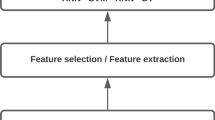Abstract
In this study, the fast Fourier transform (FFT) analysis was applied to EMG signals recorded from ulnar nerves of 59 patients to interpret data. The data of the patients were diagnosed by the neurologists as 19 patients were normal, 20 patients had neuropathy and 20 patients had myopathy. The amount of FFT coefficients had been reduced by using principal components analysis (PCA). This would facilitate calculation and storage of EMG data. PCA coefficients were applied to multilayer perceptron (MLP) and support vector machine (SVM) and both classified systems of performance values were computed. Consequently, the results show that SVM has high anticipation level in the diagnosis of neuromuscular disorders. It is proved that its test performance is high compared with MLP.
Similar content being viewed by others
References
Kumaravel, N., and Kavitha, V., Automatic diagnosis of neuromuscular disease using neural network. Biomed. Sci. Instrum. 90:245–250, 1994.
Butchal, F., An Introduction to EMG, Copenhagen, Gyldendal, 1957.
Frize, M., Ennett, M., Stevenson, M., and Trigg, C. E., Clinical decision support for intensive care unit using ANN. Med. Eng. Phys. 23:217–222, 52001.
Savelberg, H. H., and Herzog, W., Prediction of dynamic tendon forces from electromyographic signals: An artificial neural network approach. J. Neurosci. Methods 30:65–74, 1997.
Pattichis, C. S., Schofield, I. S., and Fawcett, P., A morphological analysis of the macro motor unit potential. Med. Eng. Phys. 21(10):673–679, 1999.
Nussbaum, M. A., Chaffin, D. B., and Martin, B. J., A back-propagation neural network model of lumbar muscle recruitment during moderate static exertions. J. Biomech. 28(9):1015–1024, 1995.
Bigland-Ritchie, B., Donovan, E. F., and Roussos, C. S., Conduction velocity and EMG power spectrum changes in fatigue of sustained maximal efforts. J. Appl. Physiol. 51(5):1300–1305, 1981.
Blinowska, A., Verroust, J., and Cannet, G., The determination of motor unit characteristics from the low frequency electromyographic power spectra. Electromyogr. Clin. Neurophysiol. 19:281–290, 1979.
Hiraiwa, A., Shimohara, K., and Tokunaga, Y., EMG pattern analysis and classification by neural network and application to prosthetic forearm control. IEEE Int. Joint Conf. Neural Netw., Singapore 1214–1219, 1991.
Farry, K. A., and Walker, I. D., Myoelectric teleoperation of a complex robotic hand. IEEE Trans. Robotics Aut. 12(5):775–788, 1996.
Sarbadhikari, S. N., A neural network confirms that physical exercise reverses EEG changes in depressed rats. Med. Eng. Phys. 17(18):579–582, 1995.
Perez, M. A., and, Nussbaum, M. A., Principal components analysis as an evaluation and classification tool for lower torso sEMG data. J. Biomech. 36:1225–1229, 2003.
Pfeiffer, G., and Kunze, K., Discriminant classification of motor unit potentials (MUPs) successfully separates neurogenic and myopathic conditions. A comparison of multi- and univariate diagnostical algorithms for MUP analysis. Electroenceph. Clin. Neurophysiol. 97:191–207, 1995.
Vapnik, V. N., Statistical Learning Theory, Wiley Series on Adaptive and Learning Systems for Signal Processing, Communications and Control, Wiley, New York, 1998.
Hearst, M. A., Dumais, S. T., Osman, E., Platt, J., and Scholkopf, B., Support vector machines. IEEE Intell. Syst. 13(4):18–28, 1998.
Millet-Roig, J., Ventura-Galiano, R., Chorro-Gasco, F. J., and Cebrian, A., Support vector machine for arrhythmia discrimination with wavelet transform-based feature selection. IEEE Comput. Cardiol. 407–410, 2000.
Bishop, C. M., Neural Networks for Pattern Recognition, Oxford University Press, 1995.
Fredric, M. H., and Ivıca, K., Principles of Neurocomputing for Science and Engineering, McGraw-Hill, New York, 2001.
Cortes, C., and Vapnik, V., Support Vector Machines, Machine Learning, 1995.
Pricipe, J. C., Neil, R. E., and Lefebvre, W. C., Neural and Adaptive Systems Fundementals Through Simulations, John Wiley & Sons, 2000.
Hanley, J. A., and McNeil, B. J., The meaning and use of the area under the Receiver Operating Characteristic (ROC) curve. Radiology 143:29–36, 1982.
Fuglsang-Frederiksen, A., and Ronager, J., EMG power spectrum, turns-amplitude analysis and motor unit potential duration in neuromuscular disorders. J. Neurol. Sci. 97(1) 81–91, 1990.
Author information
Authors and Affiliations
Corresponding author
Rights and permissions
About this article
Cite this article
Güler, N.F., Koçer, S. Classification of EMG Signals Using PCA and FFT. J Med Syst 29, 241–250 (2005). https://doi.org/10.1007/s10916-005-5184-7
Issue Date:
DOI: https://doi.org/10.1007/s10916-005-5184-7




